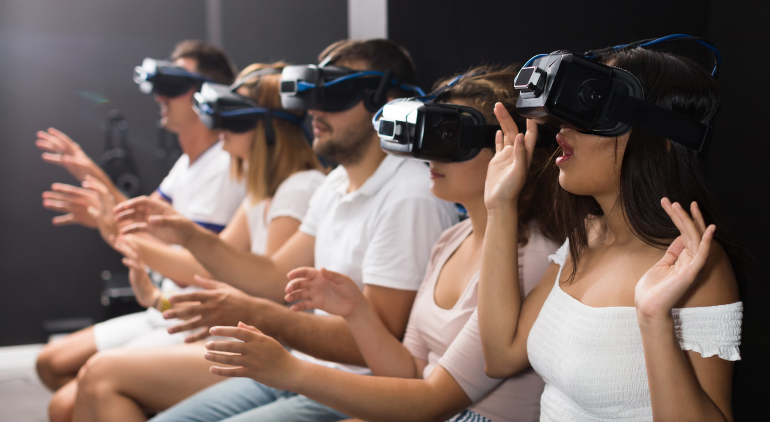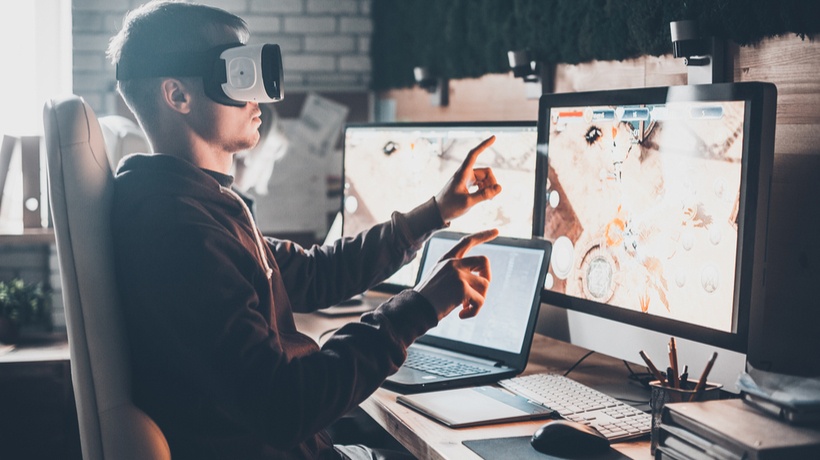10 Reasons Why Universities are Adopting AR/VR Technologies in Higher Education

Augmented Reality (AR) and Virtual Reality (VR) are types of computer technologies that create simulated and immersive realities with which one can interact. This technology, although existent from the 1950s, has a diverse range of uses and advantages.
AR and VR technology can be specialised to fit the requirements of all types of industries in all sectors. So far, AR and VR technologies have been utilised, predominantly in the tertiary sector for entertainment. Yet, it portrays the imminent future of the digital age.
One of the chief industries in the tertiary sector is that of education. Priming students towards AR and VR in higher education can allow us to carefully manoeuvre through the digital age!
It is pertinent to internalise that, with Generation Alpha, the world has taken a huge step forward into the digital age. In order to prepare for the same, VR in higher education is a necessity!
1. Learning Skills with AR and VR in Education
AR and VR benefit largely from its immersive technology which allows for those operating it to believe that they have been transported into another world. This immersive technology in higher education is a pathway to learning and polishing new skills.
VR in entertainment, especially in video games, has shown the extent of this immersive technology. Beyond developing fighting skills for video games, AR and VR applications can help place you in a highly pressured simulation.
Wherein, you will have to take a practical lab exam or perform a presentation. Skills like these can be learned from scratch or polished by simply changing the simulated environment!
2. Augmented and Virtual Reality Labs

AR and VR technologies in higher education may be costly for educational institutes overall. However, AR technology in education can make diagrams in a book become 3D with a simple smartphone that a majority of the population carries in their pocket.
VR headsets may be a little on the costlier side. Colleges can invest in VR headsets and other such equipment and save costs in laboratory settings. Industries that cater to higher education often require specialised laboratories for each discipline.
Affording equipment separately for all the labs and maintaining is not only more arduous, but costly. Hence, investing in VR labs can help save money in the long term.
3. Immersive Technology
Generation Y and Z have grown up watching technology overtake the world. There were books where there are now kindles and letters where there are now e-mails. Like these technologies, AR and VR in education will overtake the system of education, primarily because of its power of captivation!
Students will not be willing to educate themselves in higher education institutes where there are hours and hours of lectures as opposed to institutes, where there is state of the art technology like AR and VR in education that professors use along with lectures.
4. Self-learning and Self-sufficiency
Higher education is pursued by a mature set of students. AR and VR in education provides innumerable applications for all disciplines, wherein, students can learn on their own without the help of professors. This can also lead to a higher rate of efficiency.
5. STEM Education
STEM education includes complicated and abstract theoretical concepts. However, applying VR in higher education simplifies these in tangible and simple concepts that students can interact with for better comprehension.
6. Enhanced Memory Retention
The immersive technology in higher education that AR and VR will provide is, as mentioned thoroughly later, captivating. Being surrounded by a virtual world that is hardly different from the real world itself is more than enough for a higher rate of retention of memory in the long-term storage.
"Step into the future of learning! Find out why universities are using AR/VR for better education. Join us on this exciting journey!"
7. Efficiency
As aforementioned, the most intricate concepts from stem education and vr ar can be disentangled through the detailed learning that AR and VR technology can provide.
This will automatically lead to an exponential rise in efficiency because students will be able to not only comprehend complex subjects faster but also retain it for longer. This will increase the overall efficiency of students and their capability of learning.
8. Remote Learning
Online classes, especially popular this year with the pandemic surrounding us from all four sides, are a form of remote learning. You can plant yourself in India in front of your laptop and listen to lectures from a professor in the UK.
If we thought this was brilliant, then with AR and VR technology, remote learning will be enhanced drastically.
Students from all over the world can take the form of avatars that they can edit based on their preferences and attend a professor’s virtual class! All of this can happen without one even having to leave their beds.
9. Virtual Training

Engineering and medical students can specially benefit from virtual training. As aforementioned, AR VR in education help students to learn and polish skills.
This process of skill enhancement can be specialised to cater engineering students involved in practical designing and manufacturing or medical students involved in practising surgeries.
 Get the App from Meta Store: Download Now
Get the App from Meta Store: Download Now
10. Gamification and Motivation
All of the points above contribute to motivating students to invest time in their AR in higher education voluntarily. However, one thing that makes it even more appealing is the process of gamification.
Students can practise dissecting a frog virtually and get a score based on their level of precision. A low score will only force students to be motivated to perfect their skill!
The 10 commandments mentioned here are the pillars to a future of AR VR in education and how these technologies can truly be revolutionary.
However, controlling this revolutionary technology before it is unravelling of control and manoeuvring ourselves safely into the digital age is something that can be achieved by working WITH AR and VR instead of against it!
This is why universities are targeting the generation that will be first exposed to this technology on a daily basis. Soon, the entire education system along with working environments will rely on AR and VR.
.png)
.png)



